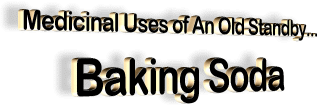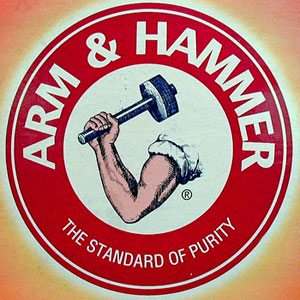|

by Gail Dutton
January 1, 1990
from
FindArticles Website
|
Baking soda, used since
B.C., is better than effervescent; sodium bicarbonate -
good old NaHCO3 - is moving out of the
refrigerator and into an amazing array of commercial
products from shampoo to industrial cleansers |
As baking soda replaces harsher
chemicals in industrial processes and finds broader uses in the
home, its future as an indispensable ingredient of modern life seems
assured.
North Americans use a billion pounds of
it each year, according to Bryan Thomlison, director of
public affairs for
Church and Dwight, the world's
major manufacturer of sodium bicarbonate located in Princeton, N.J.
"Usage is up 3 percent per year.
That's twice as fast as the population growth."
Baking soda's continued allure results
from a combination of its proven effectiveness and its position as a
natural and environmentally safe substance, as well as by
increasingly stringent government regulations such as the Clean
Water Act.
In the mid-eighties, restorers of the
Statue of Liberty used baking soda mixed with water to clean her
copper skin. Without baking soda, the process likely would have
required sand, lime or solvents.
In the same vein, sodium bicarbonate can safely remove paint,
grease, oil and smoke residue, decreasing workers' exposure to harsh
chemicals and eliminating much of the hazardous waste associated
with other cleaners.
"Sodium bicarbonate is able to clean
in areas where other substances pose fire hazards, because
baking soda is a natural fire extinguisher," says Kenneth
Colbert, a general manager for Arm & Hammer.
Since 1992, baking soda also has been
used to clean electronic circuit boards, removing the baked-on flux,
a varnish-like material that develops during manufacturing.
According to John Stevenson,
senior business manager for liquid cleaners at Church and Dwight,
a solution of sodium bicarbonate and proprietary ingredients, when
sprayed onto circuit boards, reacts with the flux to form a soluble
soap. Traditional cleaners rely upon chlorofluorocarbons, which will
be banned by 1996.
At Los Alamos National Laboratory in New Mexico, researcher Don
York has used baking soda to clean soil contaminated with
uranium. Sodium bicarbonate binds with uranium, separating it from
the dirt; so far, York has removed as much as 92 percent of the
uranium from contaminated soil samples.
Approximately 30 percent of the water supply in the United States is
acidic enough to leach heavy metals such as lead, copper, and iron
out of pipes and plumbing fixtures. Adding sodium bicarbonate to
such mildly acidic water supplies raises the water's pH and
alkalinity, which significantly reduces such leaching.
When sodium bicarbonate was added to the
water supply in Fitchburg, Mass., lead levels dropped 71 percent and
copper levels 79 percent in tap water.
Baking soda is even being used to reduce pollutants from coal-fired
power-generating plants and municipal solid-waste incinerators. The
product
Sorb-N-C combines baking soda and
activated carbon to scrub acid gases, dioxins, furans and heavy
metals that otherwise would be emitted from the stacks of
incinerators and coal-fired power plants.
Sorb-N-C is marketed to secondary
metal-smelting plant and pulp and paper plants, among others.
Our current love affair with baking soda may be relatively new, but
sodium bicarbonate has a long history. The Eloquent Peasant, an
Egyptian literary work dated around 2000 B.C., refers to a peddler
selling
natron, a natural blend of sodium
bicarbonate, chloride and sodium carbonate used in mummification.
But baking soda's first widespread use was probably as a leavening
agent for bread and other baked goods.
It has been used commercially since
1775, although the now-famous Arm & Hammer brand wasn't
introduced until 1867.

By the 1970s, the effectiveness and
gentleness of baking soda were firmly established in consumer
consciousness.
As the environmental movement grew, so
did baking soda's popularity. In a backlash against harsh cleansers,
consumers remembered that grandma - or great-grandma - added baking
soda to the laundry and used it to scrub counters and deodorize
musty rugs and pillows and wash hair.
Now sodium bicarbonate is found in hundreds of consumer products -
not only shampoo and toothpaste, but sore-throat remedies,
antiperspirants and fabric softeners. In the garage, it neutralizes
corrosion buildup on auto battery terminals, removes salt deposits
from chrome bumpers and trim, and tar and grease from headlights and
the windshield.
Arm & Hammer recommends baking soda as a water conditioner for
swimming pools, a deodorizer for kitty litter and a cleaner to
remove oil spills from garage floors.
Sprinkled on icy steps or walkways, it
aids traction and won't damage the floor if it's tracked inside. It
will remove tarnish from silver, and gold, burnt-on food from
scorched pans, built-up coffee oil and tea stains in pots and the
plastic smell from items packed in polymers.
The American Red Cross recommends that shock or burn victims drink a
weak solution of baking soda, salt and water if medical care is
delayed by more than one hour, under certain circumstances. (Do not
use it if there are convulsions, vomiting, brain or abdominal
injuries, or if later surgery or general anesthetic is required.)
An ultrapure grade of sodium bicarbonate
provides bicarbonate ions used as a buffer in dialysate fluid for
hemodialysis, a therapy that helps keep the approximately 200,000
Americans with kidney failure alive while awaiting kidney
transplants.
As a home remedy, about two tablespoons of baking soda per quart of
cool water in a bowl, or half a cup in a bath, often relieves itches
caused by rashes, poison ivy and chicken pox. A paste made from
baking soda and water is effective for treating insect bites and bee
stings, although it may dry skin. It also is used as an antacid.
On farms and ranches, cattlemen have added baking soda to feed for
ages - as a homemade bovine antacid. Arm & Hammer is developing a
sodium bicarbonate product for broiler chickens.
|

